


1940 Riverboat. Hart Tillett:
Two features are missing from this "River Boat:" her name and a hard awning. A heavy furled canvas was attached to it which was unfurled in rain.
The boat shown here was most likely used for short runs from nearby villages, not the days long journeys to the hinterlands.
Those that did, flounced their names!
 River boats travelling from San Ignacio to Belize City, long ago, a list of the settlements along the Belize Old River, names of the Belize river boats that served all those settlements and villages between Belize City and San Ignacio
River boats travelling from San Ignacio to Belize City, long ago, a list of the settlements along the Belize Old River, names of the Belize river boats that served all those settlements and villages between Belize City and San Ignacio
The Golden Era of the River Boats ran from 1893 to 1949. The Golden Era of the river boats ended when the Hawkesworth Bridge was inaugurated in 1949. Generally these boats were powered by a big diesel engine.
FIGURE YOURSELF CRUISING DOWN THE BELIZE OLD RIVER ON ONE OF THOSE RIVER BOATS. - Just three days going down.
Yes, this was what us, from the West had to endure to reach Belize City, to extract one of those KILLING TOOTH ACHES. It was a pleasure the first day, to watch the many people along the River banks living on those 107 Settlements, with pretty names like Paking Pot,- Tea kettle,- Never Delay- More Tomorrow.- Married Woman Point etc etc
But on the second day you began to miss your bed and your bathing facilities. Your fried beans, your fried eggs, Your tortilla or creole bread. BUT WE MADE IT.
THERE WERE Twenty Six of these River Boats that went up from Belize City to San Ignacio with merchandise and came down with with Passengers and Chicle blocks,and cattle and other farm produce to Belize City.
Where did those River Boats dock in Belize City?
WE ALL KNOW WHERE THE FAMOUS SWING BRIDGE IS SITUATED IN BELIZE CITY.
That was the HUB of business in those days. - SO, in this picture, you can see some of the various boats docked near bye.- This Dock was called "Melhado Wharf." and across was "Distributor Wharf and "Turton Wharf " and " BEC Wharf "
I was asked what were some of the names of the Cayo Boats.
I'LL TRY TO NAME BOAT AND OWNER:
NAMES OF THE BELIZE RIVER BOATS THAT SERVED ALL THOSE SETTLEMENTS AND VILLAGES BETWEEN BELIZE CITY AND SAN IGNACIO.
1. The Clarence Mengel. Owned by the Mengel Lumber Co.
2. The Cruizer. Owned by the Mengel Lumber Co.
3. The Cutter. Owned by David Smith & John Buckley.
4. The Tenny Fly. Owned by Aaron Arnold of Happy Home Farm
5. The Zebu. Owned by Aaron Arnold.
6. The Chicle. Owned by Henry Renton Lisbey.
7. The Cacique. Owned by Habet & Sabala (Chicle Contrators).
8. The Colosso. Owned by Emilio Awe (Mahogany Contractor).
9. The Cayo. Owned by Habet & Sabala
10. The Elenita. Owned by Edwardo Sabala.
11. The Apollo. Owned by Melhado and Sons.
12. The Minerva. Owned by Melhado and Sons.
13. The Deutz. Owned by Guy N.F. Nord.
14. The Buda. Owned by Guy N.F. Nord.
15. The Nameless. Owned by Gomez Brothers.
16. The Tireless. Owned by Gomez Brothers.
17. The Creole. Owned by John Usher.
18. The Amy. Owned by Eddie Usher.
19. The Olga. Owned by Walter Burns.
20. The Quetzal. Owned by William Wiley.
21. The San Ignacio. Owned by The Catholic Mission.
22. The Renee-B. Owned by John Mendez (after his daughter).
23. The Shultz. Owned by Guy N.F. Nord.
24. The Empress. Owned by Guy N.F. Nord.
Heron H was a sea going boat it travelled between Belize and Punta Gorda stopping at all the stops along the way. The Coloso was the largest and the Venus was the smallest but the fastest. I always looks to travel on the Venus. They were tunnel boats the prop was an a recessed cavity in the bottom to minimise damage from rocks.
AMONG THE CONDUCTORS OF THESE BOATS WERE
Somon Smith,- Facundo Audinett -Joseph Humes -,Aaron
Arnold, - Atanacio Patnett, - A Mr Haylock - Eraquio Hill - David Smith - - a Mr John Buckley, -- Mr Avington Neal - Mr E.A. Franklin and others.
When we refer to those River Boats that plied the communities along the Belize Old River, we speak of large boats that pulled large barges, loaded with all cargoes to Cayo and Peten and on the return trip, they transported tons of Chicle Blocks, cattle and agricultural products. On the front part of the boat, passengers were accommodated on this long journey.
( On the picture below is one of the Gomez' boats pulling itself by a WENC, called Warp Line) name of this boat was " TIRELESS " a sister ship to the one called " FEARLESS ".
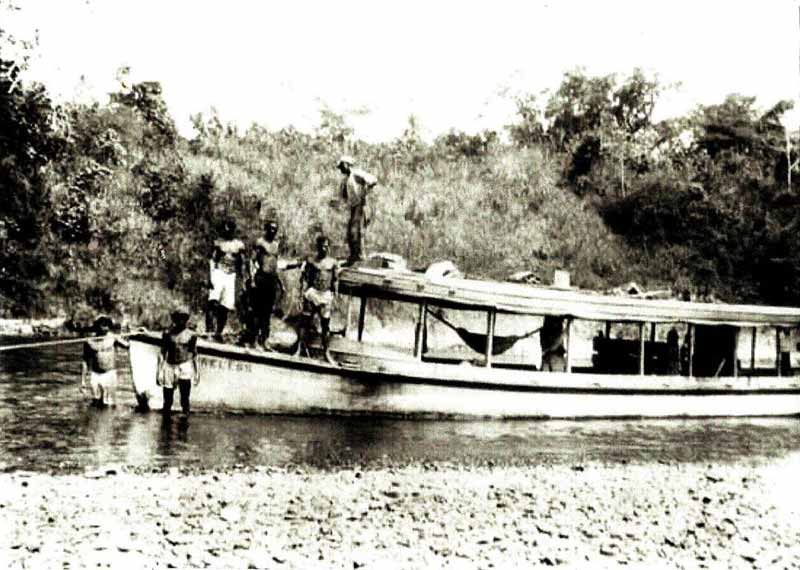
THESE WERE THE SETTLEMENTS ALONG THE BELIZE OLD RIVER that were serviced by the 26 River Boats until 1950, when the Western Highway was opened and Land Transportation took over.
Many of these settlements still exist. some of them have been renamed, and some have totally disappeared.
The names BANK and CREEK were used, to give a location.
A BANK was located along a river. A CREEK indicated that a creek passed along the settlement.
Also the word "LANDING", indicated, that River Boats stopped there on their journey. (Bermudan Landing)
The word " EDDIE or EDDY " indicated that there was a deep whirl pool in the River, (Like Black man Eddie)
THE BELIZE OLD RIVER. From Branch Mouth to Teakettle.
Begins at the Branch Mouth Villaage, then down to Bright Lookout, Johny Sam (now Santa Familia), Carmelita, Bradley's bank, Carretela Bank, Duck Run, Joe August, Santa Rosa, Saw Mill, Middle bank, Esperanza, Benque Ceiba, Tiger Bank, Baking Pot, Garbutt Creek ( now Central farm), Spanish Lookout, Morning Glory, Platon, Gentle Bank, Florial Park, Barton Creek, Little Barton Creek (now United Ville), Iguana Creek, Bucut Palace, Black-Man Eddy, Warric Head ( now Ontario), Dan Davies farm and Teakettle.
From Teakettle Village to Big Falls.
Young Gial (girl), Happy Home, New Home, San Antonio, Roaring Creek, Banana Bank, Little Orange Walk, Never Delay, Mount Pleasant, Kitty Bank Cocos, Saturday Creek, Bull Run, Salomon's Place, Cotton Tree Bank, Rock Donda, Meditation, More Tomorrow, Dancing School Eddie, Joe White Bank, Pecarry Guts, Panama, Gale Creek, Beaver Dam, Castille, Cocrico Run, Baboon Eddie, Laboring Creek, Married Woman Point, Monkey Run, Big Haulover and Big Falls.
From Big Falls to Burrel Boom.
Cock Loft (or Laugh), Society Hall, Johny Young's Bank, Sutherland Bank, Double Head Cabbage, Jim Cotto, Hunt's Point, Bermudan Landing, Scotland and Half Moon, Isabella Bank, Bamboo Patch, Flower;s'Bank, Lime Walk, Burns' Pen, May Pen, Black Creek, Grace Bank, Jones Bank, Mexico Creek, Baker's Ranch, Double Run and Burrel Boom.
From Burrel Boom to Belize City.
Mitchell's Pen, Bolton's Bank, Van Tuy's bank, Gabourel's Bank, Evan's Bank, Hofius Mango Walk, Halouver Mouth and into Belize City.
Photographs courtesy Hector Silva
The River Boats of British Honduras
Researched by: George Villanueva
Before the construction of the road to Belize City in 1925, the river provided the highway and chief means of communication with the outside world Over land travel on horseback was arduous and slow. River travel was not much faster. Until the invention of the steam engine, it consisted of boats that had to be paddled or rowed.
The earliest mention of larger vessels traveling the river is that of the launch sent by the Governor following the battle in 1872. A boat called the "Pioneer" was in regular service in 1875, and might have been one of the first to run the regular route between Belize City, Corozal and Orange Walk, with stops at the villages along the way. The "Fredie M." was carrying mail when it was wrecked near Corozal in 1895.
The turn of the century ushered in the golden age of the northern steamers. One of the earliest boats of this period was an unnamed one owned by Katherine A. Leitch. This eighty-foot steam vessel carried ten cabin and forty deck passengers. The ""Egarton" (a 114 foot, twin-engined vessel) was licensed in 1914 and the "Star" (a two-decker) was licensed in 1916. The "Star" took a day and a half to reach Belize City from Orange Walk. In 1920, the "Star" carried fifty men of the Volunteer Guard into Belize for a shooting competition.
Perhaps the best-known vessel was the "Africola" (72 tons) owned by L.G. Chavannes and registered in 1922. She left Belize on Mondays at noon for Corozal and the New River, with stops at Pueblo Nuevo, Caledonia and San Estevan. She returned to Belize on Thursdays. The First Class fare was $6.50 and the Second Class fare was $3.25. Freight charges included $0.50 for a bag of rice, $0.10 for a box of candles, $0.40 for a bag of corn, and $0.25 for a block of chicle.
Besides carrying the mail and passengers, the river steamers brought in to Orange Walk; rice, boxes of condensed milk, drums of oil, kegs of butter, candles, salt, flour, barrels of pork and pigtail, and (carefully packed into barrels) bottles of Chavannes Lemonade; the real "Afri-Kola" for which the boat was named. It carried back to the City: chicle in blocks (each stamped with the owner's initials) corn in sacks, green avocados and ripe pineapples, oranges, bananas, and watermelons from San Estevan. From the mill of J.W. Price came brown sugar in 100 pound sacks. From Caledonia came pigs, alligator skins, and tobacco leaves bound into bundles. And from the Gonzalez distillery came fifteen and twenty-five gallons casks of "Taste-Tells" rum. With the construction of the road to the City in the late 1920's and early 1930's, it was only a matter of a few years before the slow-moving steamers were replaced by trucks. The "Chapulin" was the last steamer in regular service. It was owned by R.S. Turton and registered in 1923. It carried six First Class or cabin passengers and twenty Second Class or deck passengers. The "Chapulin" made its final voyage in 1939 under Captain Felipe Magaria.
Long time residents mention two other boats as traveling to Belize from Orange Walk on a regular basis: the "Florin" and a boat called the "L.G.C." (or L.A.C.)
Orange Walk was also the terminal for another fleet of boats - those operated by the Belize Estate and Produce Company in its logging operations. Two of the earlier company boats were the paddle wheeled steamer "Don Felipe" of 24 tons (registered in 1890) and the "Alpha" a stern paddle-wheeler in service about the same time.
The "Ella" was a motor schooner of 59 tons, registered in 1903 by the Belize Estate and Produce Company, which later sold it to the Escalante family of Orange Walk. It was used to haul out logs and after it had outlived its usefulness, it was driven up a creek in the vicinity of Trial Farm and burned.
Though the New River still serves as a highway for the rafts of logs, and for the barges of sugar and molasses produced at Tower Hill, the time when it was the sole link with the rest of the world has long passed and the northern steamer has become the stuff of history.
Alexander Montero had a sail boat called the Sunbeam that use to sail between Punta Gorda and Belize city in the 1920s. Used to carry carry pigs to Belize city.
According to the 1925 handbook of British Honduras the Sunbeam was a 6 ton sloop registered to George J Morey of Long Coconut Caye in 1907.
Am presuming Mr. Montero bought the Sunbeam from Mr Morey.
The Riverboats, and "the "Afrikola"



Some names of rapids or runs on the Belize River
1. SEVEN BELLS Run or Rapids
2. THREE SISTERS
3. DUCK
4. PLATUN
5. PULL FROCK, Pull frock was in the area of Peter Banner property in Ontario. It was called Pull frock because the ladies pulled up their dress so that it does not get wet.
6. TYGER
7. SALECIA
8. BAKERS
9. DOUBBLE
10. KING
11. MONKEY RUN
12. MONKEY FALL
13. UTILE FALL
14. BIG OR SPANISH FALL
15. SMITH (RUN OR RAPID)
16. MALIHECKY
17. ROCK DONDA
18. MIDDLE STATION
19. SPANISH LOOKOUT
20. PULL-OR-BE-DAMNED RUN
21. CATTO
22. MC COY POINT
23. JOHN CROW
24. CROSSING LANDING
25. MC KENZIE
26. BARK LOG
27. LORRETA
28. CARIBAL POINT
29. BEAVER-DAM
30. MOUNT PLEASANT
31. SOCIETY HALL
32. MOUNT HOPE
33. CHOONE
34. OLD MAN CANNTPASS
35. GABOUREL (NEAR CAYO) (VERY LAST ONE)
36. MAMEE RUN
37. YOUNG GAL BUMP RUN
38. NOON DAY FALLS
39. CLARISSA FALLS
40. CADDIE DAVID. 1/4 mile up stream, left ascending bank is "Little Scotland" from Burmudian Landing Bridge 1750.
NOTE: Some spelling of names might be incorrect, but I try to enter them just as my informers speak and some of them are in Creole.
Harold Usher:
They used to be our source of food supply to Belize City, from places like Sibun! That is if you were not too proud to go and shop at the Market, Court House Wharf and by the River Side, when the boat stopped off on Sunday Evenings on its way in from Sibun to the Belize Market! The waterways were nice and clean and healthy, except for the Canals!
Elsie Felix-Edmunds:
One of the things I remember most when we spent holidays with family along the Sibun was watching one relative in particular as she sat regally in her dorie, paddling slowly, the oar barely touching the water with her fishing line trailing behind her. I don't remember what kind of fish she was skilled at catching but the image has stayed with me.
I'm talking about Aunt Tiny/Frances Usher Smith, my great aunt or grand aunt as we say in Belize.
Boat Names and Owners
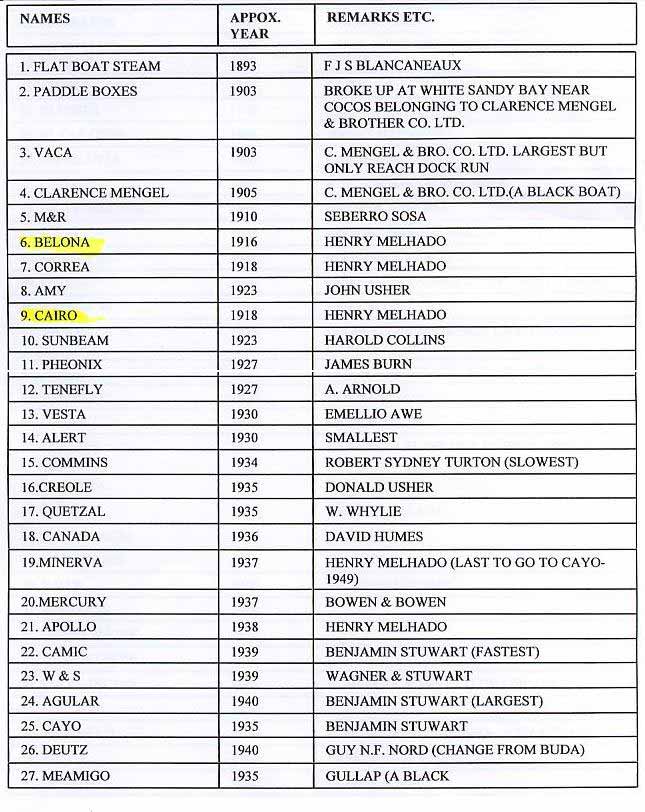
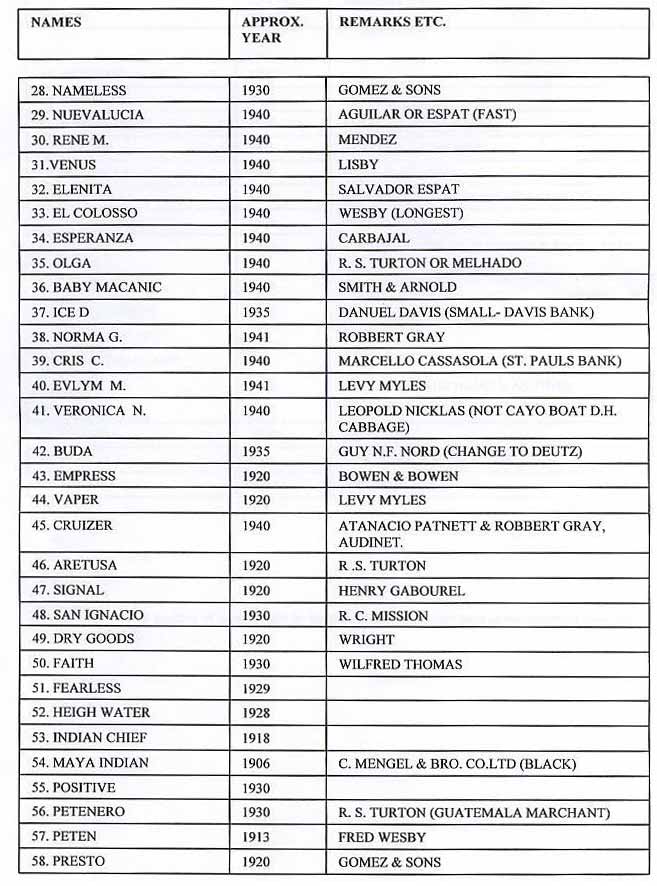
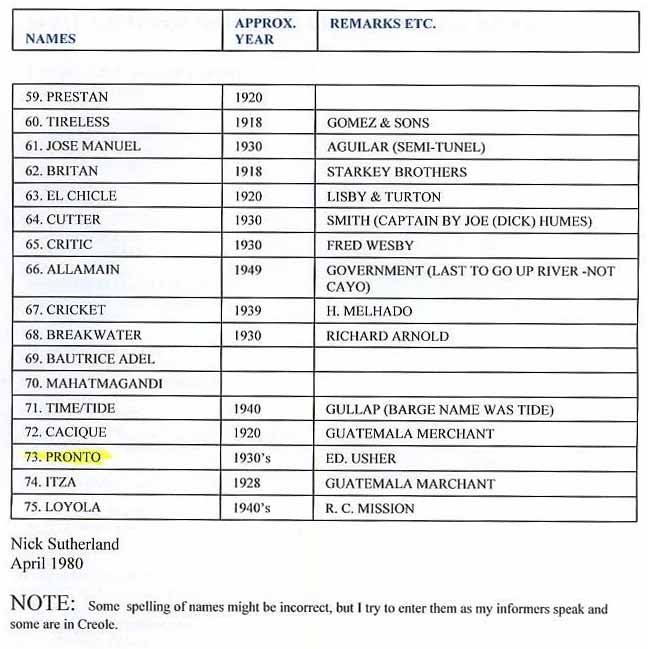

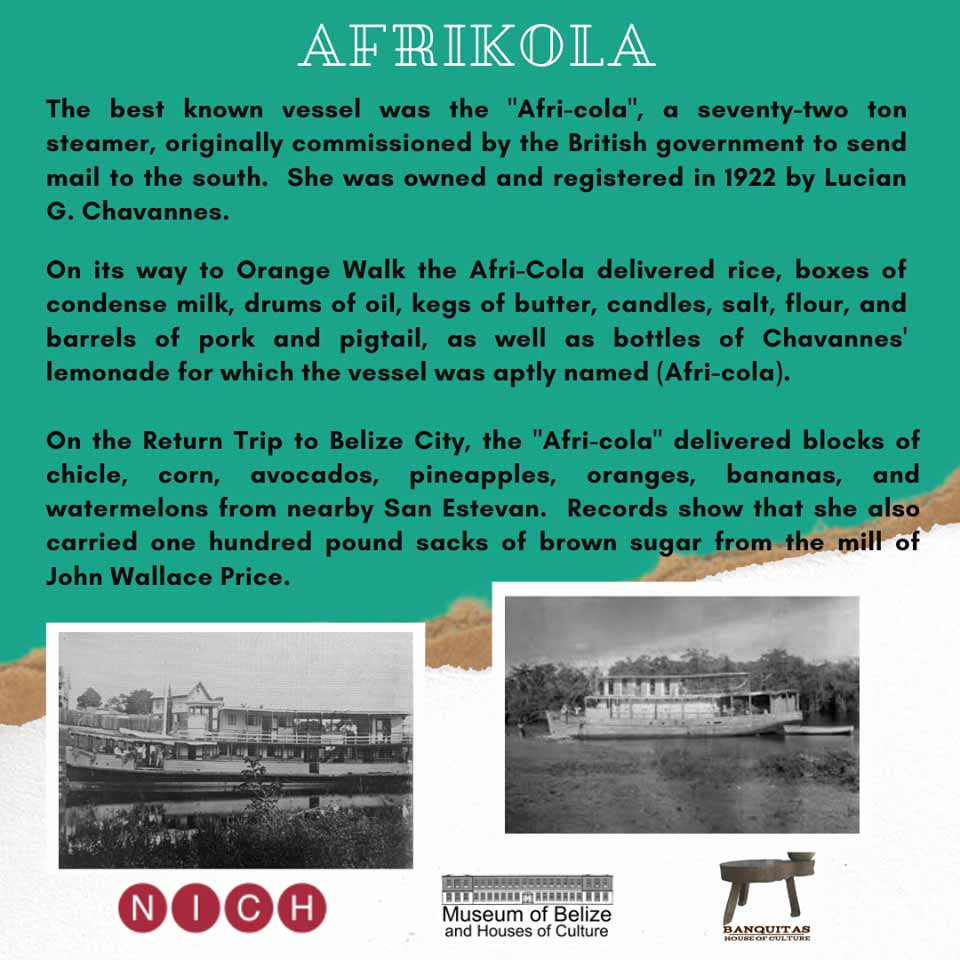
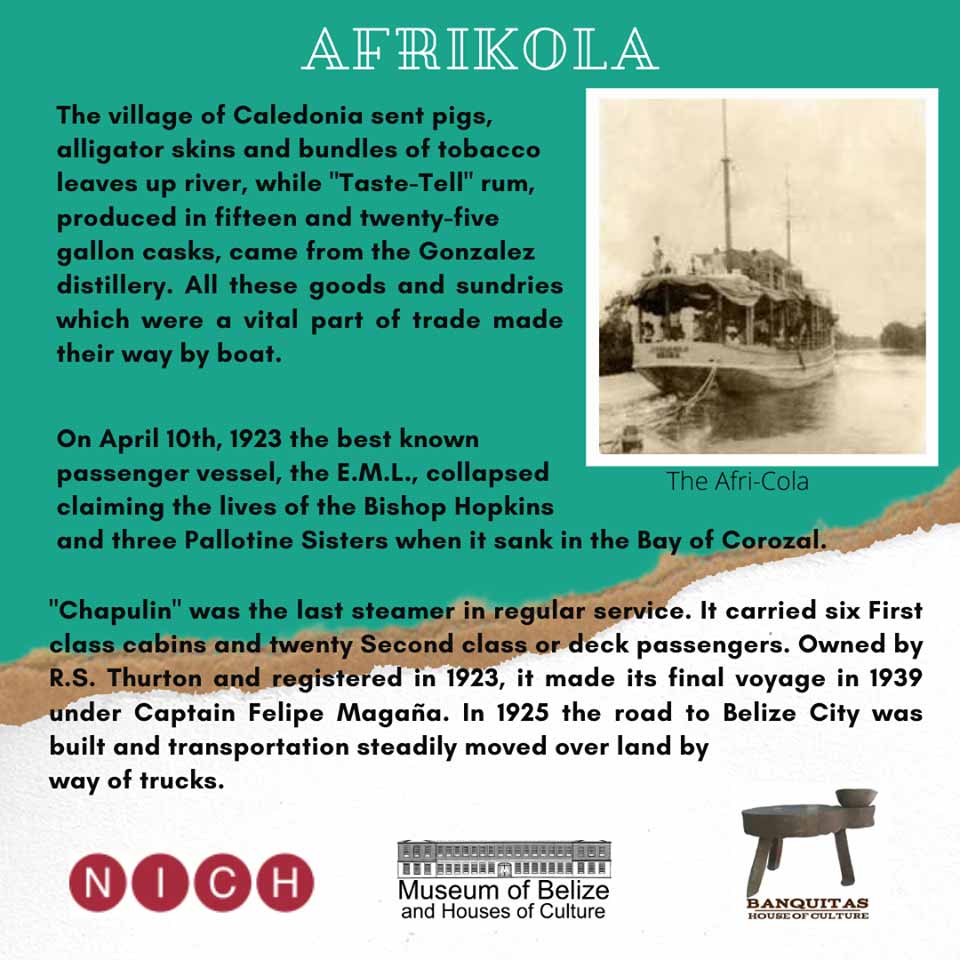

Boats on the Belize River heading to El Cayo, 1920s.
HERE IS A HISTORICAL FEAT ON THE MOPAN RIVER, BY A RIVER BOAT
by Hector Silva
The Mopan river has many water falls, which makes it almost impossible for a motor boat to navigate, not even an Air Boat. So trade to Benque Viejo and beyond had to be done by land. At the beginning with mules or horses and eventually by roads.
It is written somewhere, that had the Mopan River been navigable, Benque Viejo would have been the Capital of the Cayo District. - The Chicle Industry actually had its beginning in Benque Viejo, with the chicle which came from across Peten through FAYA BUN and PLANCHA DE PIEDRAm ( Now Melchor. ) - The Mahogany industry was very large in Benque Viejo. There is a large area, known as LA BACADILLA. where logs from both side of Belize and Peten were deposited, waiting for the flooded Mopan to carry them away..
There was even a large TRAIN SERVICE established behind Benque Viejo, by the Clarence Mengel logging Company of the USA.
In fact, Father Andrew Bavastro S.J., the founder of the San Ignacio Catholic Mission initially visited Benque Viejo in search of the establishment of the Western Mission, - The Pallotine Sisters came and went straight to Benque Viejo and established their first Convent.
SO the owners of the River Boat "EL CACIQUE" Habet & Sabala, decided to make an experimental trip up the Mopan River, during a high flood. The Cacique was captained by the famous Don Facundo Audinett.
The Cacique left San Ignacio at 9.00 AM, on the 23rd of October 1908, and arrived at San Jose Succotz about 2 PM. - Early the following morning, she proceeded to Benque Viejo, arriving at 8.00 AM.
It is said, that when the loud HORNS were blown, " The whole Town, with the exception of the sick turned out to see this wonderful sight of, " EL VAPOR. " It is also said that the visit of El Vapor turned out into a Large Fiesta, with Marimba music and bollos and tamales were served free in honor of EL VAPOR CACIQUE.
Early next morning, The Cacique had to steam back out of the Mopan River , or it would stay there until another flood.
This joyous story was followed in the Dry Weather, in the early 1930's when the Great Peter Moguel, brought a primitive MODEL T FORD car from Belize City to San Ignacio.
He also decided to visit Succotz and Benque Vejo through a narrow horse trail, with a few trimmings.
Upon his passing through the towns, he BLEW HIS CAR HORN. - In those days only the Police was allowed to blow a LOUD WHISTLE. - Then the citizens had never seen a Car.- So it is said that a citizen shouted. " PITO DE POLICE, VAPOR DE TIERRA !" ( translated to '' POLICE WHISTLE, LAND BOAT".
( These are some of the anecdotes of the River Folk Clore, which made our lives happy.) - There were many sweet and many weird stories about our rivers. - It was my pleasure to listen to those river people, like myself tell those never ending RIVER STORIES.
LIFE ON THE BANKS OF THE BELIZE OLD RIVER, as I lived it from birth
by Hector Silva
My answer is, A LIVING PARADISE here on earth. - An enjoyable means of communicating with Nature. - A spot on earth to speak directly with Almighty God.
Early in the morning, the surface of the river is covered with a thin cloud of fog. - The temperature of the water is Tepid. You can take a dive or a swim without feeling a sting of cold. - But upon coming out the waters, you better have a towel or cloth to cover.
The mist or fog keeps the vegetation by the river irrigated, so that it is always humid and verdant. -The fruits along the river are always Juicy, such as the Bri Bri, the Capulin, the Bucut, Supa, and wild Berries.
In my younger days, we did not have to go to the market to buy fish. Either we checked our extended fishing line, or we throw our line with hook and bait and sinker and we selected what fish we preferred for the Mid-Day meal.
The SELECTION consisted of BACA, SNOOK, TUBA, DORMILON, JUREL, ROBALO, SHEEP HEAD, BLANCO and the smaller ones like sardines to DEEP FRY like chicharon with tortilla. - Some times one would see a pair of TARPONS in the deeper parts. ( these tarpons went up during floods.)
BUT IF YOU WANT TO KNOW, in the dry, we would fill our buckets with fresh water shrimps. ( by lifting rocks where they hide. )
Then there was the week ends, when we would paddle down the river in search of GAME MEAT. Early in the morning, all kinds of animals come down to the river to drink water. such as , Deer, Antelope, Gibnut, wild pigs like Pecarrie and Warrie. - Sometimes a Jaguar or a Tapir.
The Belize like other rivers had its own folklore. The Duhende, The lady washing clothes on moonlight nights. - The mermaid in certain eddies. A giant whose legs spanned the river etc.
BUT THE MOST NOTORIOUS ONE TO THIS DAY WAS, " Andrew Cain and his violin.- I was told from I am young, and even as the Representative of Area about this Andrew Cain. According to many witnesses, Andrew Cain would collect orders from his neighbors for goods from Belize City. They would give him the money. - He would leave at DAY BREAK in his dorey, with his violin playing AND BY NIGHT FALL, Andrew Cain was back with the goods ordered.
Later when I travelled to Punta Gorda I was told of an Andrew Cain, who had migrated to PG. - He dis some weird things, like bleeding chicle in DRY WEATHER. (almost an impossibility,) -I heard his humble house got burnt with him inside.
SO HERE I REST my CASE on ESCERPTS from ONE of MY MANY BOOKS, ( This one being, "THE BELIZE OLD RIVER. "
Belize had great eras when there was an economic boom, which kept the British Honduras Colony in a good financial status.
Looking at the pictures above, we see the heavy traffic of River Boats from Belize City to San Ignacio. There were some 26 Boats, which plied this route.
In some instances there were five Boats discharging Cargo at any one time, destined for San Ignacio and Surrounding Areas, for Benque Viejo and Succotz and the Department of El Peten, Guatemala.- On their journey back they would bring Chicle Blocks. The river boats would then bring back Chicle Blocks, Cattle and Poultry, Pigs, Agricultural products and of Course Passengers.
Because these boats could not go to Benque Viejo, because of the many shallow Water Falls on the Mopan River, all Cargo had to be taken by Packs of Mules. These mules would travel as far as Flores Peten, Guatemala AND on their way back, they would bring Chicle Blocks to the Boat Wharf, destined to Belize City for the Export Market.
In those days the West was very prosperous, so much so, that TACA Airways opened a daily flight with their single engine planes in the early 1930's, to cater for the large Mahogany and Chicle Industries.
( On a foot note. A part of our currency in those days was GOLD COINS called SOL worth $5.00 - and SILVER COINS called REALES worth 12 1/2 cents.
Click here to comment on this picture.
Belize Slideshow

Click here for a list of previous pictures of the day
Click here for a large selection of photographs and videos of Belize
 Email us - We Email us - We your photographs. Send us yours with a description! your photographs. Send us yours with a description!
 Belize Search.com
Belize Search.com  Belize News.com
Belize News.com  Belize Cards.com
Belize Cards.com  Belize History
Belize History  IslandBazaar.net
IslandBazaar.net  Belize Weather
Belize Weather 
 Belize Lodging
Belize Lodging  Tours & Recreation
Tours & Recreation  Diving & Snorkeling
Diving & Snorkeling  Fishing
Fishing  Travel Tips
Travel Tips  Real Estate
Real Estate 
 AmbergrisCaye.com
AmbergrisCaye.com  Island Information
Island Information  Visitor Center
Visitor Center  Belize Business
Belize Business  San Pedro Sun
San Pedro Sun 
 SanPedroDaily.com
SanPedroDaily.com  Belize Message Board
Belize Message Board  Restaurants
Restaurants  Things to do
Things to do 
|